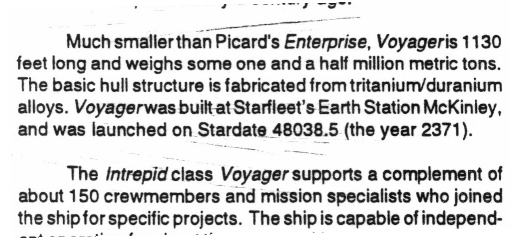Have we ever determined canonically whether Voyager's 700,000 metric tons is the mass of the ship or the mass of the ship plus fuel and provisions?
Canonically? How would I know? I come here a treknology novice to ask questions and suck brain. I can only speculate on what might make some modicum of sense.
I guess we all know about the controversy of what Scotty said in
TOS: Mudd's Women about gross tons versus what most people take as the mass of Kirk's Enterprise, where in naval or merchant marine terminology gross tonnage means cargo capacity.
While it's unfair to hold busy people to information given in a preliminary manual, a snippet of which I posted in this thread, we might speculate that if that figure is close to correct it could mean fully loaded, versus empty mass given in the aforementioned references, so approximately 1,500,000 M.T. loaded and 700,000 M.T. empty.
We have something similar with trucks. On Yahoo! Autos I can see weight of 4,707 lb. for a certain pickup truck, max./standard payload of 1,693, and GVWR of 6,400.
So the weight (mass) figure means empty but including jack and spare, while GVWR (gross vehicle weight rating) means fully loaded, with people, cargo, fuel, handbags, beverages, etc.
For this particular 2011 model, GVWR isn't double the stated vehicle weight, but for the prototype SUV built by the Rocky Mountain Institute, it might be, since it's made mostly of carbon, with a body that snaps together rather than using bolts (the atomic number of carbon is 6, while that of iron is 26).
But for a starship that might be in the ballpark, given the argument I made previously about probable high carbon content in structural material of future space vessels.
So I could at least speculate that empty mass for the Intrepid class is the twice-stated figure of 700.000 M.T. while the loaded mass might well be the approximately 1,500,000 M.T. stated in that early draft of the Technical Manual.
But, of course, that seems even further from the TOS-oriented view that these figures are already way too high, even though we have a popular figure of 190.000 M.T. for the E versus gross tonnage of "almost a million" mentioned by Scotty.





